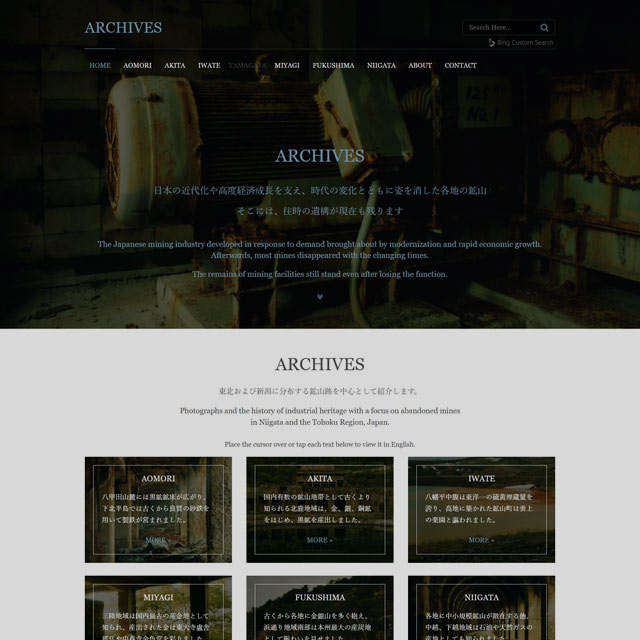AOMORI
下北半島から八戸に至る沿岸地域は古くから砂鉄の産地として知られ、国内最大の産出量を誇りました。
The coastal regions from Shimokita to Hachinohe were Japan's largest iron sand-producing areas.
東北と新潟の鉱山跡に残る遺構を写真に記録し、
下北半島から八戸に至る沿岸地域は古くから砂鉄の産地として知られ、国内最大の産出量を誇りました。
The coastal regions from Shimokita to Hachinohe were Japan's largest iron sand-producing areas.
多くの黒鉱鉱山を抱えた北鹿地域は国内最大の金属鉱山地帯に発展し、昭和後期に繁栄を築きました。
The Hokuroku area, with numerous black ore mines, grew into Japan's largest metal-mining area.
釜石、松尾は国内最大の鉱山としてそれぞれ鉄、硫黄を産出し、日本の鉱業を牽引しました。
Kamaishi and Matsuo Mines were known as Japan's largest iron and sulfur mines, respectively.
三陸地域は国内最古の産金地として知られ、本吉荘で採取された砂金は中尊寺の金色堂を彩りました。
The Sanriku region was the earliest gold-producing area, and Motoyoshi-Kin was used at Chusonji.
歴史ある金銀山が多く点在した他、阿武隈山地の東麓地域は本州最大の産炭地として栄えました。
Historic gold and silver mines were scattered, and coalfields lay along the Abukuma Mountains.
佐渡の金銀山に加え、日本海沿岸の地域に広がる油田、ガス田はともに国内最大の規模を誇りました。
Alongside gold and silver from Sado, the prefecture had Japan's largest oil and natural gas production.

鉱業生産が拡大した戦時体制下の 1940 年、東北では 1,161 の鉱山が操業され、80,647 人の労働者が鉱業に従事しました…
In wartime 1940, the number of mines and employees in the Tohoku region totaled 1,161 and 80,647, respectively…

原料は下北半島北岸部を中心とする砂鉄鉱区、石灰石は尻屋鉱区、石炭は同社経営の青葉炭鉱からそれぞれ自給されました…
Most of the raw materials, such as iron sand, limestone, and coal, were sourced from mining areas managed by the company…

鉱山の歴史概要、解説文の一部に加筆、修正を行いました…
Revised some parts of the history and summary…

鉱山の歴史概要、解説文の一部に加筆、修正を行いました…
Revised some parts of the history and summary…
© 2016 ARCHIVES
Template by OS Templates